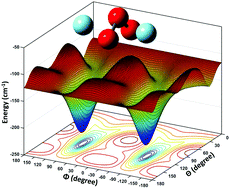Development of a potential energy surface for the O3–Ar system: rovibrational states of the complex†
Abstract
The cycle of formation and destruction of ozone is an important process in the atmosphere. A key step in the formation process is the stabilization of a metastable ozone molecule, which occurs through energy transfer: usually a highly excited ozone molecule loses the excess energy through inelastic collisions with a third body (M). However, the details of this energy transfer mechanism are still not well known and one of the reasons has been the lack of an accurate potential energy surface (PES). In theoretical studies, Ar is often selected as the third body when considering O3–M dynamics. However, electronic structure calculations have not previously been reported for the complex. In this paper we benchmark the electronic structure for this system, and present our first steps towards constructing a fully flexible 6D PES by obtaining a 3D PES in the rigid rotor approximation. For this purpose, to benchmark the non-bonded interactions, we performed ab initio electronic structure calculations using explicitly-correlated coupled-cluster theory extended to the complete basis set limit (CCSD(T)-F12b/CBS). A multireference-based protocol suitable to describe the 6D flexible system was developed using the explicitly-correlated multi-reference configuration interaction (MRCI-F12) method. Subsequently, we used the AUTOSURF code to construct 3D PESs for each of the two methods with global root-mean-squared errors of less than 1 cm−1. The PES is characterized by two equivalent wells on either face of the ozone molecule consistent with the symmetry of the system. Calculations of the rovibrational levels for the complex using the Multiconfigurational Time Dependent Hartree (MCTDH) method provide insight into the states and dynamics of the system. Based on symmetry analysis, the allowed states and transitions were obtained: the transition frequencies and calculated rotational constants were then compared with previously reported experimental measurements. The isotopic effect was also studied using the 16O18O16O and 16O16O18O isotopologues. Roughly a doubling in the density of allowed states is observed when the symmetry of the ozone molecule is broken.

- This article is part of the themed collection: 2019 PCCP HOT Articles


 Please wait while we load your content...
Please wait while we load your content...